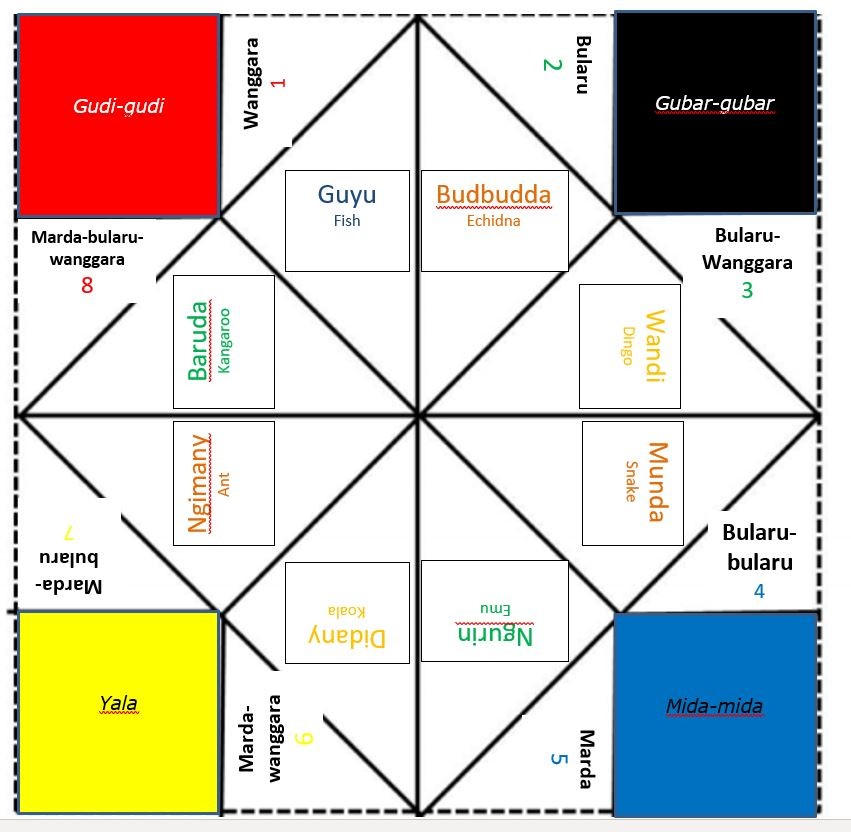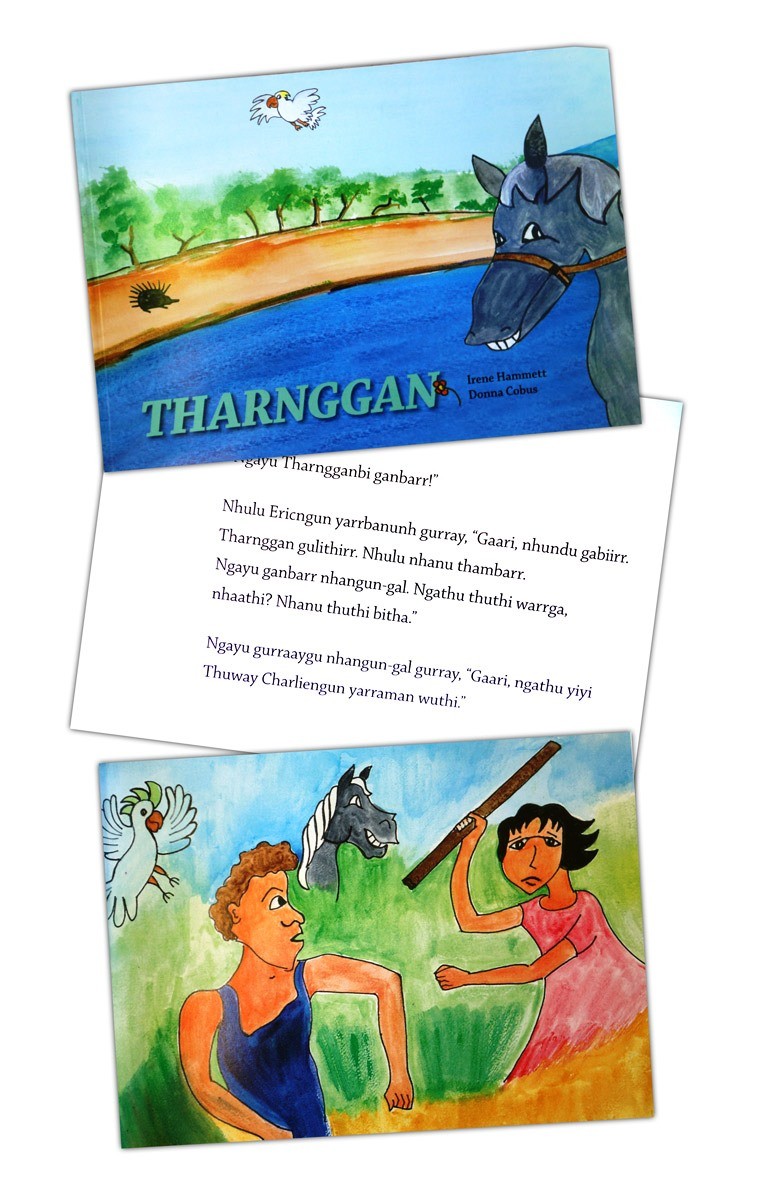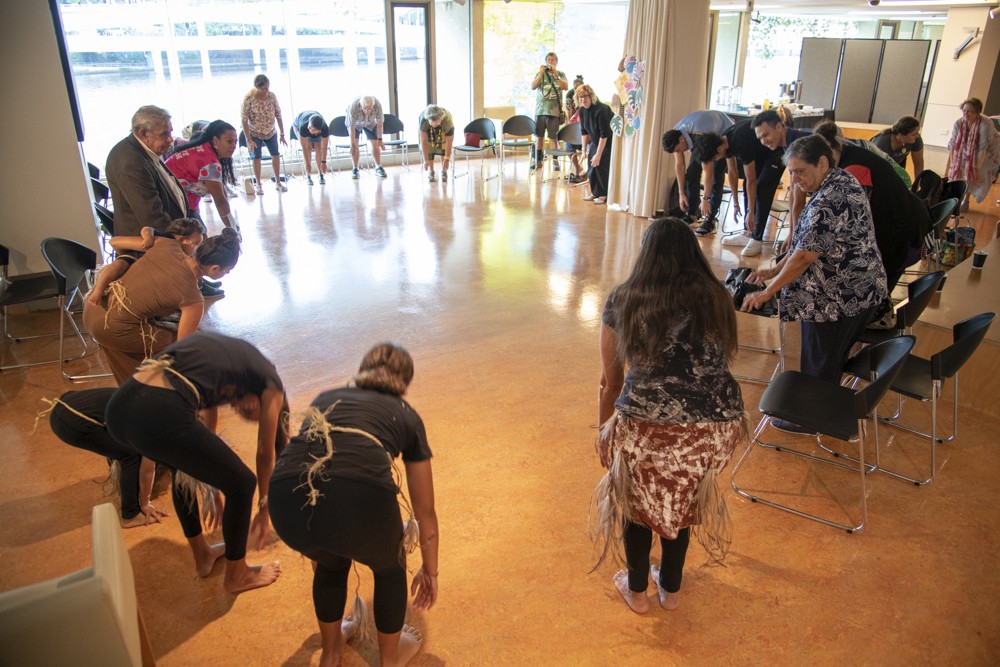Language activities for Aboriginal and Torres Strait Islander Children's Day
By dcrump | 3 August 2021
National Aboriginal and Torres Strait Islander Children's Day is celebrated annually on the 4 August - this year's theme is Proud in culture, strong in spirit. The Secretariat of National Aboriginal and Islander Child Care (SNAICC) have been coordinating this annual event since 2008.
This blog post will explore some ideas and activities for languages with young children.

Chatterbox in Gunggari language.
Chatterboxes are a fun activity that helps you learn 20 everyday words from the local language - the image above shows an example from Gunggari language of the Maranoa region. It features language words for numbers, colours and animals; other everyday words can be added with different chatterboxes!

Tharnggan - a Guugu Yimidhirr story by Irene Hammett.
Stories and storytelling is a popular way to learn about Aboriginal and Torres Strait Islander languages - the State Library collections have an extensive range of books with language content - check your local public library or Indigenous Knowledge Centre. The image above shows a Guugu Yimidhirr story created and published by Irene Hammett from Hope Vale. See if there are any local stories featuring language from your region!

Participants learning 'Heads, shoulders, knees and toes' in Yuggera language.
Another fun and easy activity is learning 'heads, shoulders, knees and toes' in the local Aboriginal or Torres Strait Islander language. State Library has a selection of everyday words, including parts of the body on the Aboriginal and Torres Strait Islander language webpages - better still, ask a local community member to come along and teach the children!
Other activities for schools and communities include:
- Welcome / Welcome to Country work with local community members to create a welcome in language at your school, main reception, classroom.
- ‘Word of the Week’ – have a different word each week in your school, child care centre, community, etc.
- Language Circle – host informal gathering of Elders, language custodians and other community members to meet in the school space to share language. Choose a theme each month, e.g. ‘favourite language word’; ‘animals’; ‘family’, etc.
- Language Nest – similar to a language circle but aimed at little ones; an informal gathering of mums, bubs and nans to play and talk together using language. This could be used as part of a First 5 Forever program along with rhymes, songs and games in language.
- Record / document language speakers from the local community – collect language, stories, songs, oral histories to add to the school’s local collection. Explore options for publishing and sharing them across the community.
- Build up word lists for common/everyday things (e.g. family names, body parts, plants, animals, placenames, etc.); create a ‘language word wall’ in the classroom; produce a school-community dictionary of everyday words for the local language/s.
- Learn greetings / farewells in the local Aboriginal and/or Torres Strait Islander language(s) – use daily in classroom, parades, assemblies, etc. and have these on signs in the school and community.
- Dual signage / labels in the school and community – English and the local Aboriginal and Torres Strait Islander language.
- Incorporate language activities into key events / displays, e.g. NAIDOC & Reconciliation Weeks; Mother Tongue Day; Aboriginal and Torres Strait Islander Children’s Day; etc. Plan and host school-community events.
- Language Resources – make your own flash cards, chatterboxes, body charts, posters, etc. for language words.
- Language through Art / Stories – work with community members to create books, artwork, songs using language.
- Host a community language event, e.g. festival, forum or similar event to celebrate language in your town, city or community!
- Indigenous Author / Storyteller-in-Residence – host an Aboriginal and Torres Strait Islander writer, poet, storyteller in your school; don’t forget local community performers, artists.
- Have a language display / language corner / language wall in your classroom or school library!
While language can be celebrated as part of National Aboriginal and Torres Strait Islander Children's Day, the State Library encourages everyone to explore and use Aboriginal and Torres Strait Islander languages at other times during the year.
For more information on National Aboriginal and Torres Strait Islander Children's Day, visit the SNAICC website.
Desmond Crump
Indigenous Languages Coordinator, State Library of Queensland
State Library of Queensland Aboriginal and Torres Strait Islander Languages Webpages
State Library of Queensland Aboriginal and Torres Strait Islander Languages Map
Weblinks:
SNAICC National Aboriginal and Torres Strait Islander Children's Day 2021 website
References and Further Reading
The following is a selection of children's books from the State Library's collections that feature Aboriginal and Torres Strait Islander languages.
Bowen, L. and Calley, K. (2016) Gudaa bula dyugi-dyugi = The dog and the chook. JUV 499.15 BOW
Cape Treasures: Children from Cape York Share Stories.
Cherbourg State School (2009) Budburra's alphabet. JUV A823.4 BUD
Crombie, J. and Barr-Crombie, J. (2014) Children's Talking Book. JUV 499.15 CRO
Crombie, J. and Barr-Crombie, J. (2018) Looking for Tucker. JUV 499.15 CRO
Dreise, G. (2014) Silly Birds. JUV A823.4 DRE
Dreise, G. (2019) My culture and me. JUV A823.4 DRE
Erbacher, J. and S. (1998) Jarruka the scrub hen. JUVQ 641.391 ERB
Gordon, T. and Haviland, J. (1980) Milbi: Aboriginal tales from Queensland’s Endeavour River. JUVQ 398.20994 GOR
Hammett, I. (2013) Tharnggan. Illustrated by Donna Cobus. JUV 499.15 HAM
Hammett, I. (2014) Bidhagurr Wuurili Bunhdhiwi. Illustrated by Donna Cobus. JUV 499.15 HAM
Hill, C. and Thompson, D. (2012) Lockhart River language readers Umpila and Kuuku Ya'u languages. HKT 418 HIL
Jack, P. (2014) Turtle and wallaby : Barun ban Garnjin. Told by Phil Jack; illustrated by Year 2 students at Mornington Island State School. JUV 299.9215 JAC
Jarl, M. (2014) The legends of Moonie Jarl. Retold by Moonie Jarl (Wilf Reeves) ; illustrated by Wandi (Olga Miller). J 398.2 MOO
Kennedy, V. (2017) Amra Niighi Laenae : the boys go walkabout. JUV499.15 KEN
Korkaktain, V. (2008) Minh Nga’an Wichan = Catching fish told & illustrated by Venita Korkaktain. JUV A823.4 KOR
Lawrie, M. (1970) Myths and legends of Torres Strait. Q 398.2099438 MYT
McRobbie, N. (1996) Who's that Jumbun in the log? JUVQ A823.3 M'RO
Mirndiyan Gununa Aboriginal Corporation (2014) Two boys and two devils : a traditional Yangkaal story from Forsyth Island. Illustrated by Year 3 students at Mornington Island State School. JUV 299.9215 TWO
Mirndiyan Gununa Aboriginal Corporation (2014) Seagull and Crane : a traditional Lardil story. Illustrated by Year 4 students at Mornington Island State School. JUV 299.9215 SEA
Nalingu Aboriginal Corporation (1994) The Tiger Snake (and other stories). JUV 499.15 TIG
Omeenyo, G. (1987) The crocodile. JUV A823.3 ome
Santo, W. & Nancarrow, C. (2006) Gudjal book of animals. JUV 499.15 SAN
Walker, D. and Griffiths, L. (2011) Island treasures : Torres Strait children share stories. Collected by Dot Walker and Lynnette Griffiths for the State Library of Queensland. JUV A828.4 ISL
Comments
Your email address will not be published.
We welcome relevant, respectful comments.